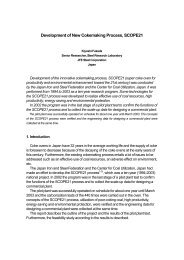Defining CCS Ready: An Approach to An International Definition
Defining CCS Ready: An Approach to An International Definition
Defining CCS Ready: An Approach to An International Definition
- No tags were found...
Create successful ePaper yourself
Turn your PDF publications into a flip-book with our unique Google optimized e-Paper software.
Chapter 2: Capture <strong>Ready</strong> Plant <strong>Definition</strong>applicant <strong>to</strong> apply for a Hazardous Substances Consent (HSC), if the plant is expected <strong>to</strong> useand dispose of hazardous substances in future capture facilities. 39 Project developers in theUK are encouraged <strong>to</strong> discuss plans for capture at an early stage with the local planningauthority <strong>to</strong> determine if an HSC might be needed.2.4.3 Public Awareness and Engagement ActivitiesPublic awareness and engagement activities are an important component of <strong>CCS</strong> <strong>Ready</strong>plants because public opposition <strong>to</strong> <strong>CCS</strong> has been shown <strong>to</strong> delay or result in thecancellation of projects (especially since <strong>CCS</strong> is still is a relatively unknown technology <strong>to</strong>the general public), and early engagement with the public will help identify and alleviatepotential public concerns that can be a barrier for retrofit.Getting the buy-in of the general public may be critical for the success of a <strong>CCS</strong> <strong>Ready</strong> plant,as well as the eventual <strong>CCS</strong> retrofit. While nations differ in the degree <strong>to</strong> which communityacceptance is sought during and after policy development, experience <strong>to</strong> date indicates thatcommunity acceptance may be very important for <strong>CCS</strong>, particularly when CO 2 transportand s<strong>to</strong>rage activities will be located in pristine or populated areas. In some areas,communities may have a role in approving projects, or have other means of voicingconcerns, such as lawsuits, protests, or media campaigns.Although <strong>CCS</strong> is still a relatively unknown technology <strong>to</strong> the general public, 40 initial opinionson <strong>CCS</strong> matter as these opinions, once formed, are slow <strong>to</strong> change. 41 Studies have shownthat public acceptance of <strong>CCS</strong> increases with exposure <strong>to</strong> more information, and NGOs aretrusted most as conveyers of this information (industry is trusted least). 42A developer that forges alliances with the NGO community, think tanks, or universities mayhave better chance of gaining public support than one that does not. 43 A recent report fromthe US DOE recommends that public outreach be an integral component of <strong>CCS</strong> projectmanagement, beginning at the initial planning stages and continuing throughout the lifetimeof the project. 44 The IEA has highlighted the need for early public outreach <strong>to</strong> addresspotential concerns of local communities, and provide information about technologies andplanned projects, risks of <strong>CCS</strong>, and what is being done <strong>to</strong> keep communities safe. 4539 Paragraph 75, pg 28 of U.K. Department of Energy and Climate Change (U.K. DECC). (2009a). Carbon capture readiness(CCR): A guidance note for Section 36 Electricity Act 1989 consent applications (Publication no. URN 09D/810). London,UK: Author.40 Intergovernmental Panel on Climate Change (IPCC). (2005b). IPCC Special Report on Carbon Dioxide Capture and S<strong>to</strong>rage:Summary for policymakers. A special report of Working Group III of the Intergovernmental Panel on Climate Change.41 Ashworth, P. et al. (2009). <strong>An</strong> integrated roadmap of communication activities around carbon capture and s<strong>to</strong>rage inAustralia and beyond. Energy Procedia, 1, 4749-4756. doi:10.1016/j.egypro.2009.02.300.42 Shackley, S., Reiner, D., Upham, P., deConinck, H., Sigurthorsson, G., & <strong>An</strong>derson, J.. (2009). The acceptability of CO2capture and s<strong>to</strong>rage (<strong>CCS</strong>) in Europe: <strong>An</strong> assessment of the key determining fac<strong>to</strong>rs: Part 2. The social acceptability of <strong>CCS</strong>and the wider impacts and repercussions of its implementation. <strong>International</strong> Journal of Greenhouse Gas Control, 3, 344-356. doi:10.1016/j.ijggc.2008.09.004.43 Acceptance of CO2 Capture and S<strong>to</strong>rage, Economics, Policy and Technology (A<strong>CCS</strong>EPT) Project. (2007). The A<strong>CCS</strong>EPTproject: Summary of the main findings and key recommendations (DNV-BRINO912GSIG2007-2078).44 U.S. Department of Energy, National Energy Technology Labora<strong>to</strong>ry (U.S. DOE-NETL). (2009). Public outreach andeducation for carbon s<strong>to</strong>rage projects. (DOE/NETL-2009/1391).45 <strong>International</strong> Energy Agency (IEA). (2009a). Technology roadmap: Carbon capture and s<strong>to</strong>rage. Paris, France: Author.23 February 2010 31
















